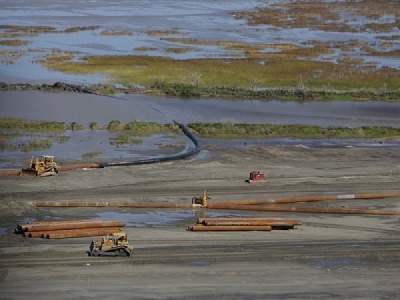
Posted on September 27, 2018
Bordered by beautiful wetlands along the Gulf of Mexico, Louisiana is a hub of transportation and industry. A pilot environmental impact bond could seed a set of wetland-restoration projects for the state. Environmental Defense Fund (EDF), Quantified Ventures, and their project partners are proposing to draw on funding from the Deepwater Horizon oil-spill settlement to make this happen.
The proposed pilot-project location is Port Fourchon, which is on the Gulf Coast. This port is a crucial node for shipping and energy. But land loss due to coastal erosion and storms threatens to shut it down.
“If you look at a map of Port Fourchon, you’ll see there is one access highway that is very exposed,” said Carolyn duPont, director at Quantified Ventures. “And then the port itself – all the infrastructure, including all the docks and all the buildings that are on the site – is pretty low-lying and very vulnerable to storms.”
According to a report the team has produced, Louisiana loses over 1.3 acres of land every 100 minutes as wetlands become open water. Over the next half-century, the state will lose an area close to the size of Connecticut due to coastal erosion, sea rise, and marsh damage if no action is taken.
This has a brutal effect on the state’s economy and safety. Storms and erosion are wiping out coastal communities.
But environmental restoration could help stem the tide of land loss.
The state of Louisiana recognizes this emergency. It has created a Coastal Master Plan directing $50 billion of investment from multiple sources over 50 years toward structural and shoreline protection, hydrologic projects, marsh creation, island and ridge restoration, oyster reefs, and sediment diversions.
This would reduce land loss by 513,920 acres. It would also save the state $150 billion in storm-damage costs. If carried out, the plan would create a resilient Mississippi River Delta where communities, commerce, industries and fisheries could still thrive. The Coastal Master Plan has a very solid base of support, the report said – including unanimous state legislative backing.
This pilot project would fulfill a part of this plan.
“The reason that we think a corporation or an asset owner might be interested in participating in this transaction is basically the ability to stay in business in that geography,” duPont said.
“We were impressed by how positive the responses were,” duPont said after hearing from a large number of stakeholders.
Potential partners who might provide performance payment are expressing interest in the project, said Shannon Cunniff, director of coastal resilience at EDF.
“In our engagement with [United States impact] investors, there was a lot of interest in supporting Louisiana,” duPont said. “There are a lot of opportunities to engage investors around the country in Louisiana’s efforts and support those efforts.”
What Role Energy and Industry Play
In addition to the massive state-level economic advantages described above, protecting Louisiana’s coastal industries is crucial from a national energy-security standpoint.
“Probably 20 percent of the nation’s energy comes through here,” said Steve Cochran, associate vice president of coastal resilience at EDF. “We’re trying to create a line of defense within a multiple-line-of-defense strategy.”
ConocoPhillips, a fossil fuel company, owns the wetland where the pilot restoration project might be sited. Initial conversations have shown the company is interested in hearing more about the potential project, duPont said.
How the Financing Model Would Operate
“The feedback from investors was to keep things simple, especially for the pilot,” Cunniff said.
Source: Conservation Finance Network





